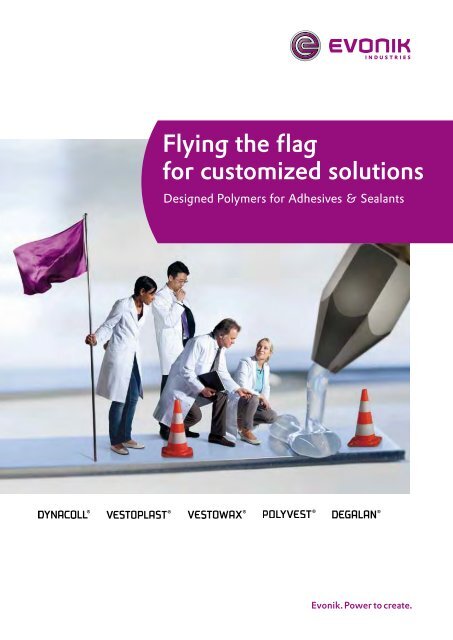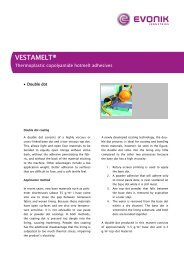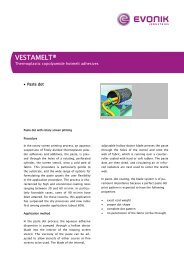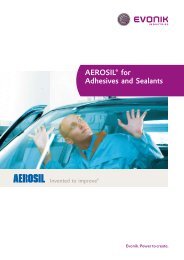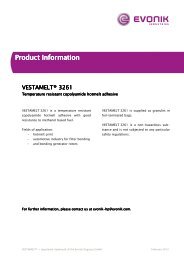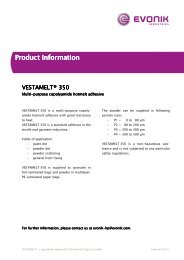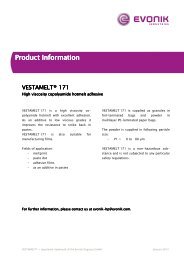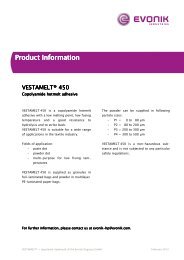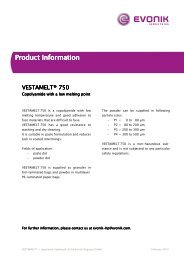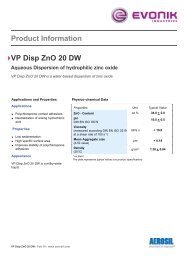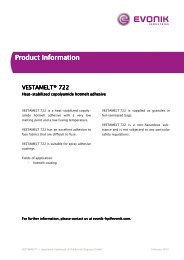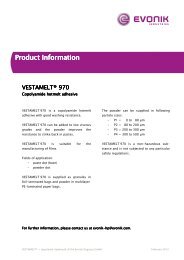Sales Folder Adhesive Resins - Adhesives & Sealants by Evonik
Sales Folder Adhesive Resins - Adhesives & Sealants by Evonik
Sales Folder Adhesive Resins - Adhesives & Sealants by Evonik
- No tags were found...
Create successful ePaper yourself
Turn your PDF publications into a flip-book with our unique Google optimized e-Paper software.
Focus on Customer Orientationand ReliabilityAn eye for innovation. Attention to customer needs.As the experts within <strong>Evonik</strong> for the <strong>Adhesive</strong>s & <strong>Sealants</strong> Industry, we are dedicatedto customer service. We want to position ourselves as a provider of customizedsolutions and be the first choice of our customers when it comes to resolvingchallenges in the adhesives and sealants industry.Thanks to our global presence on all five continents and in more than 100 countries,we can respond flexibly and personally to the needs of our partners. This includesrapid innovation and the quick advancement of unique products and system solutionsfrom the idea stage to market maturity – for the development of innovative polymersand formulations and for demanding optimizations alike. Our goal is to developsolutions that provide maximum benefit for our customers and our society.You give us your trust. We give you our word.We are convinced that closeness to customers and developing solutions inteamwork are the keys to success. That is why we work closely with our partnersand involve them actively into our research and development work. This approachhas helped us advance a number of highly successful solutions around the world.The relationship with our customers is characterized <strong>by</strong> reliability and trust.There is good reason why some of our customer relationships have existedfor more than 25 years. We always treat our partners as equals and take themand their wishes very seriously. We consider it fundamental to keepour word and to guarantee a consistently high quality standardfor our solutions.
Know-Howand Future OrientationOur milestones set the standard and secure success.Our success is based on our expertise in research and development. Our researchteams around the world allow us to maintain and expand our technology leadershipin the area of adhesives and sealants. In short, we set milestones.The close dialog with our partners produces innovations that stand out for theiroptimized performance, high efficiency and improved environmental compatibility,such as polymers with excellent bonding properties, better adhesion and optimizedcuring properties.Our milestones include tailor-made granulated amorphous poly(alpha)olefins,polyester polyols for moisture-curing one-component hot melt adhesives, reactivesilane-modified amorphous poly(alpha)olefins, as well as acrylates and bio-basedpolyesters for reactive hot melts – in addition to highly reactive liquidpolybutadienes for high performance adhesives and sealants and acrylic-basedheat sealing lacquers for superior seal and peel performance.These are just some examples of the unique solutions we have developed to unlockspecific applications and enhance the global productivity and success ofour customers.Knowledge is the way. The future is the goal.Our goal is to conquer new markets and to consistently stay a step ahead, torecognize trends, and to use them profitably for our partners. Future viability andsustainability are particularly important factors in this regard. We not only keep aneye on the here and now, but also never forget about tomorrow and cominggenerations.This approach is reflected, for instance, in our nearly 100% solvent-free productrange and the most recent example of our innovative strength: bio-based polyesterpolyols,a new product group developed on the basis of renewable raw materials.Our new investment in hydroxyl-terminated polybutadiene (HTPB) expands ourportfolio and positions us to provide solutions related to megatrends like energysaving and resource efficiency.6
Our competenciesfor designed polymersCapabilitiesResearch & DevelopmentApplied TechnologyAnalytical DepartmentEngineeringScale-up and Production FacilitiesMarketing & <strong>Sales</strong>Global PresenceLogisticsCustomer NeedsExcellent cohesionHigh adhesive strengthtowards individual substratesHigh tackinessEnvironmental performanceHigh energy savingsFast cycle timesExcellent initial strengthAdjustable open timesBackbone ChemistryPoly(alpha)olefinesPolyestersPolyacrylatesPolybutadienesFT-Waxes7
<strong>Adhesive</strong> networks ofProduct Line <strong>Adhesive</strong> <strong>Resins</strong>Science-to-Business Center:<strong>Evonik</strong>’s cooperation frameworkfor working together with externalpartners, universities and institutes•Bio-Technology•ECO 2 : Focus Energy Efficiency•NanotronicsASC: The <strong>Adhesive</strong> and Sealant Council (USA)IVLV: Industrievereinigung für Lebensmitteltechnologieund Verpackung e.V. (Germany)EWF: European Wax Federation (Europe)IVK: Industrieverband Klebstoffe e.V. (Germany)FEICA: Association of European <strong>Adhesive</strong> andSealant Industry (Europe)BASA: British <strong>Adhesive</strong>s and <strong>Sealants</strong> AssociationFPA: Flexible Packaging Association8UPDATE 1 - 08/2013
Our dedicated sales forceis committed to ourglobal customer approachGermany (north)ScandinaviaR. Katerrolf.kater@evonik.comphone +49 2156 109 174Germany (south)AustriaSwitzerlandL. Malmedyludger.malmedy@evonik.comphone +49 8251 870157FranceBenelux CountriesUnited KingdomR. Strobberonny.strobbe@evonik.comphone +32 475 283834ItalySpainPortugalA. Gognaalberto.gogna@evonik.comphone +39 02 333 008 49TurkeyE. Oncemre.onc@evonik.comphone +90 216 395 9961RussiaS. Kovalerovsergey.kovalerov@evonik.comphone +7 495 721 2862RomaniaBulgariaA. Mehedintualexandru.mehedintu@evonik.comphone +40 31 71 00786Other Eastern EuropeT. Sabljictomislav.sabljic@evonik.comphone +385 1 3862 674USACanadaH. Terwillegarheather.terwillegar@evonik.comphone +1 973 929-8466M. Leonmercedes.leon@evonik.comphone +1 973 541 8821S. Engertsabine.engert@evonik.comphone +1 973 541 8924MexicoG. Marquezgabriela.marquez@evonik.comphone +52 55 5483-1000South AmericaJ. Thomaz de Melojoaquim.melo@evonik.comphone +55 11 3146 2156ArgentinaG. Avellagabriel.avella@evonik.comphone +54 9 11 57562069UAESaudi ArabiaS. Artesachin.arte@evonik.comphone +971 4 204 5586EgyptA. Nousserahmed.nousser@evonik.comphone +20 2 7948 242IranA. Nayeriali.nayeri@evonik.comphone +9821 2222 3402109IndiaS. Parabsuresh.parab@evonik.comphone +91 22 6723 8800JapanA. Yamamotoatsushi.yamamoto@evonik.comphone +81 3 5323 7409K. Sugikiyoaki.sugi@evonik.comphone +81 3 5323 7360KoreaJ. Kimjason.kim@evonik.comphone +82 2 2072 2398South/East AsiaD. Handaryl.han@evonik.comphone +65 6 809 6843A. Chenaumpa.chen@evonik.comphone +6627847913ChinaJane Chenjane.chen@evonik.comPhone +86 21 6119 1470J. Qianjerry.qian@evonik.comphone +86 21 6119 1343TaiwanR. Chengroger.cheng@evonik.comphone +886 2 2717-1242AustraliaNew ZealandA. Windsorandrew.windsor@evonik.comPhone +61 3 858184049UPDATE 1 - 08/2013
Customized solutions fordiverse marketsAutomotiveBonding & Lamination InteriorCar Carpets<strong>Adhesive</strong>s & <strong>Sealants</strong> for Different ApplicationSound DampingWindowsHead Lamp <strong>Adhesive</strong>sConstructionFlat Lamination, Sandwich ConstructionProfile Wrapping & Edge BondingSand Filled Mortar<strong>Sealants</strong>/ Insulated Glass <strong>Sealants</strong>ElectronicsFlexible Flat CablesCable Filling / Jelly CompoundsElectrical Insulations & Potting CompoundsLifestyleCarpetsHygieneTextile IndustrySilicone Based Consumer <strong>Sealants</strong>MattrassesPackagingFlexible PackagingPaper & PackagingPharmaceutical Blister-PackFood PackagingOther MarketsBitumen ModificationPolymer Modification / MasterbatchesRoad ConstructionPlastic ProcessingRenewables / Solar ApplicationsFlexible Printing Plates / Defoamers / PU Foams10UPDATE 1 - 08/2013
Our polyester-polyols, copolyestersand polyacrylates for your reactiveand thermoplastic hot melts.Our amorphous poly-alpha-olefins(APAOs) are co- and terpolymersof ethene, propene and 1-butene.They are particularly useful forproducing hot melt adhesives.Our synthetic waxes produced<strong>by</strong> the Fischer-Tropsch processact as your value additive forhot melt applications.Our liquid polybutadienes foryour adhesives & sealants arestereospecific, low viscous andunsaponifiable.Our methacrylat bindersfor heat sealing applicationsin pharmaceutical blister-packsand food packaging.12UPDATE 1 - 08/2013
13Application Insights
Dynacoll® 7000Preparation of Reactive Hot MeltsMolten DYNACOLL® grades are charged and heated up to approx. 130 °C. The meltis dried for 45 min. at less than 10 mbar. Water evaporation is important to avoidcrosslinking reactions and to obtain good shelf life and viscosity stability of theRHM.The calculated amount of isocyanate is added under a weak stream of protective gas(dried nitrogen or carbon dioxide) and rapidly homogenized with the melt. Reactiontime is normally 45 min. at 120 – 130 °C.The reaction is finished after the theoretical value of isocyanate content is reached.The isocyanate content is determined <strong>by</strong> reaction of the RHM with an excess ofdibutylamine and titration with hydrochloric acid. The melt should be degassed untilit is free of bubbles. Afterwards the reactive hot melt is filled into containers andstored in the absence of moisture and light. Depending on the application it isrecommended to filter the melt.For quality control, the following data should be determined: isocyanate content,visosity at elevated temperature, melting point or softening point (R&B), open time.Calculation:Weight (diisocyanate) =(WPES1 . OH1 + WPESn . OHn) . EW . R56110WPES1 = weight of polyester 1OH1 = hydroxyl number polyester 1WPESn = weight of polyester nOHn = hydroxyl number polyester nEW = equivalent weight of diisocyanate usedR = ratio of isocyanate to hydroxyl groupsReactive Hot Melt adhesives based on Dynacoll® 7000• offer excellent bonding to a huge variety of substrates• provide solutions for versatile applications in diverse industries,e.g. wood working, automotive, packaging and textile industry,also for bookbinding applications and sandwich bonding• can be applied with standard hot melt equipment,e.g. roll coaters, bead, spray and melt print applicators etc.27
Dynacoll® 7000Reactive Holt Melt DataReaction products of DYNACOLL® with 4,4’- diphenylmethane diisocyanates (MDI) as a ratio of OH : NCO = 1 : 2.2PropertiesMelt ViscosityGradeSofteningPoint(R&B)[°C]Open Time[s]Setting Time[s]TensileStrength[N/mm 2 ]Elongationat Break[%]130 °C[Parallel plate][Pa s]Amorphous7110 1) 64 10 1 brittle 37111 71 6 1 brittle 137130 88 1 1 brittle 507131 88 1 1 brittle 457140 102 1 < 1 brittle 7007150 105 < 1 < 1 brittle 400Liquid7210 45 several hours several hours 15 800 57230 several hours several hours 15 900 97231 several hours several hours 15 900 87250 several hours several hours 15 1,500 97255 40 several hours several hours 30 1,100 5Crystalline7362 55 130 35 25 400 27360 59 80 15 25 400 47363 61 50 15 25 400 117365 63 50 15 20 300 187361 63 50 10 20 300 307381 67 35 3 20 80 57380 73 20 1 20 20 57330 85 35 3 25 15 37320 87 40 35 35 500 487340 97 120 60 30 700 127331 110 90 30 30 500 207390 118 20 10 30 10 47321 123 70 25 35 400 301)available on special request28
Dynacoll® 7000Analytical MethodsHydroxyl NumberDetermination according to DIN 53 240-02.Approx. 2-3 g of polyester are dissolved in dichloromethane or THF. The OH groups areesterified at RT with acetic anhydride, using 4-dimethyl-aminopyridine as catalyst. Afterhydrolysis of the unreacted anhydride, titration is carried out with 0.5 N methanolic KOH.Acid NumberDetermination according to DIN EN ISO 2114.Approx. 4 g of polyester are dissolved in 50 ml of tetrahydrofuran. Following addition of 50 mlof a mixture of equal parts <strong>by</strong> weight of tetrahydrofuran and ethanol, titration is carried outwith methanolic or ethanolic KOH against phenolphthalein.Molecular WeightThe molecular weight is calculated based on the sum of hydroxyl number and acid number.Glass Transition TemperatureDetermination according to DIN 53 765.The glass transisition temperature is determined as for the melting point.Melting PointDetermination according to DIN 53 765.The melting point is determined using a DSC instrument. The sample and an empty referencecrucible are heated at 20 °C/min. The melting point corresponds to the maximum of themelting peak. To ensure better reproducibility, it is customary to use the values from thesecond heating operation.Softening Point (Ring and Ball)Determination according to DIN ISO 4625.The sample is cast as a melt into a ring and the ring, following the solidifaction of the melt(or the recrystallization in the case of crystalline substances), is inserted into a test frame. Thesample is stressed concentrically with a chrome-plated steel ball and the test frame is immersedin a bath of glycerol. The glycerol is heated at a rate of approximately 5 °C/min. The softeningpoint (R&B) is the temperature of the glycerol bath at the time when the steel ball contacts thebaseplate of the test frame.DensityDetermination according to DIN 51 757.Flash PointDetermination according to ISO 2592.Open TimeDetermination according to <strong>Evonik</strong> internal method.The material is heated up to 130 °C and applied on paper as an approximately 0.5 mm thickfilm. Strips of open surface paper are pressed into the melt at certain intervals. After theadhesive film is tack-free the paper strips are removed. The open time is given <strong>by</strong> the time,when no fiber tear can be observed anymore.30
Dynacoll® 7000Analytical MethodsSetting TimeDetermination according to <strong>Evonik</strong> internal method.The setting time is given <strong>by</strong> the time it takes until two bonded wooden cubes canno longer be twisted against each other <strong>by</strong> hand.Melt ViscosityDetermination according to DIN EN ISO 3219, parallel plate method.Tensile Strength / Elongation at BreakDetermination according to DIN 53 504.Dumbbell specimens are punched out from a 0.5 mm thick moisture cured RHM film.Curing conditions are 7 days, 20 °C and 65 % rel. humidity. Elongation at break denotesthe percentage increase in length of an original section of 10 mm marked on the barof the dumbbell specimen, at the moment of break.31
Dynacoll® SDesigned Polymers for <strong>Adhesive</strong>s & <strong>Sealants</strong>CopolyestersWith its DYNACOLL® S product range <strong>Evonik</strong> offers thermoplastic copolyestersof high molecular weight to a wide variety of thermoplastic hot melt and solventbased applications.The individual grades differ in their melting point, degree of crystallinity andhardness and in their setting time. According to their crystallinity, the productrange is arranged into four basic groups:• DYNACOLL® S - Highly crystalline grades• DYNACOLL® S - Moderately crystalline grades• DYNACOLL® S - Slightly crystalline grades• DYNACOLL® S - Amorphous gradesDYNACOLL® S copolyesters are generally supplied as granules,usually in bags of 20 or 25 kg.They can be processed into following forms of applications:adhesive film, web or net, powder, paste, hot melt and solution.Your benefits• DYNACOLL® S - Highly crystalline grades• short open times and high heat resistance• good solvent and chemical resistance• DYNACOLL® S - Moderately crystalline grades• moderate open times• very good adhesive strength and heat resistance• DYNACOLL® S - Slightly crystalline grades• long open time with good heat resistance• excellent adhesion on a large number of substrates• DYNACOLL® S - Amorphous grades• good solubility in many solvents• very good adhesion on a large number of substrates32
Dynacoll® SProduct RangeProperties Melt Flow Rate (MFR) [g/10 min] Melt Viscosity [Pa s] Solubility GradeSofteningPointMeltingPointGrade [°C] [°C] [°C]GlassTransitionTemp.HydroxylNumber[mgKOH/g]AcidNumberViscosityNumberShore DHardnessOpen TimeTensileStrengthElongationat Break[mgKOH/g] [cm 3 /g] [s] [N/mm 2 ] [%] 160 °C 180 °C 200 °C 220 °C 160 °C 180 °C 200 °C 220 °CMethylene chlorideTrichloroethyleneEthyl acetateMEK(methylethyl ketone)TolueneHighly crystallineS 243 195 195 35 68 79 5 40 7 130 240 50 – – – – – S 243Moderately crystallineS 341 HV 160 150 -30 80 55 10 15 50 200 300 500 30 20 10 + – – – – S 341 HVS 341 160 150 -30 65 52 10 15 30 300 600 750 20 10 5 + – – – – S 341S 1272 140 128 0 84 53 10 25 400 30 60 120 250 330 140 65 + – – – – S 1272S 1252 135 120 2) 20 94 64 5 20 450 20 45 900 360 180 + – – – – S 1252S 1247 130 120 2) 5 85 46 10 25 450 30 60 110 240 120 60 + • – – – S 1247S 1218 130 115 15 80 63 20 20 300 30 60 110 210 300 150 80 + • – – – S 1218S 320 1) 120 100 -40 80 32 40 10 600 240 500 10 5 3 + – – – – S 320 1)S 1227 115 100 10 80 63 5 15 350 40 90 150 240 240 120 60 + • – – – S 1227Slightly crystallineS 1450 135 125 2) 0 5 1 87 33 15 25 700 80 140 220 110 40 + – – – – S 1450S 1402 100 90 2) -10 5 3 78 27 15 10 400 100 220 360 80 50 30 10 + + – – • S 1402S 1401 97 85 2) -25 6 2 80 19 15 5 500 110 190 290 80 40 25 15 + + • • + S 1401S EP 1408 90 80 2) -30 4 2 87 17 50 2 300 75 130 200 100 55 30 15 + + + + + S EP 1408AmorphousS 1606 155 65 4 2 62 80 15 60 5 30 60 150 90 + + + + – S 1606S 1611 130 50 4 2 61 79 10 20 3 100 190 70 15 + + + + + S 1611S 1426 140 35 4 2 90 78 20 50 5 15 30 60 270 + + + + + S 1426S EP 506.01 125 40 6 5 65 80 5 130 230 + + + + + S EP 506.011)available on special request1)available on special request2)optical methodAll data given are typical values+ = > 10% (soluble)• = < 10 % (slightly insoluble)– = < 1% (virtually insoluble)33
Dynacoll® SApplicationsHighlyCryst.GradeModeratlyCrystalline GradesSlightlyCrystalline GradesAmorphousGradesS 243S 341S 341 HVS 1272S 1252S 1247S 1218S 320S 1227S 1450S 1402S 1401S EP 1408S 1606S 1611S 1426S EP 506.01Textile IndustryHot Melts ▯ ▯ ▯ ▯ ▯<strong>Adhesive</strong> film ▯ ▯ ▯ ▯<strong>Adhesive</strong> web and net ▯ ▯ ▯Profile WrappingPVC Window frames ▯ ▯ ▯Metal / Plastics bonding ▯ ▯ ▯ ▯ ▯Metal primer ▯ ▯ ▯ ▯Electronic IndustrySolvent based adhesives ▯ ▯ ▯ ▯ ▯Hot Melt adhesives▯Automotive IndustryAir filter bondings ▯ ▯Interior textile lamination ▯ ▯ ▯Decorative film lamination ▯ ▯ ▯ ▯Packaging IndustryBiodegradeable adhesives▯Flexible packging ▯ ▯ ▯ ▯Polymer ModificationAdditive for Reactive Hot Melts ▯ ▯ ▯Masterbatches▯34
Dynacoll® SAnalytical MethodsOpen TimeDetermination according to <strong>Evonik</strong> internal method.The open time is defined as the time between the application of the adhesive and the startof recrystallization – or in case of amorphous products until the surface becomes tack-free.Tensile Strength / Elongation at BreakDetermination in accordance with DIN EN ISO 527-1/3.It is determined on standard dumbbell-shaped specimens. The elongation at break denotesthe percentage increase in length of an original section of 10 mm marked on the bar of thedumbbell specimen, at the moment of rupture.Melt Flow Rate (MFR)Determination according to DIN ISO 1133.Approx. 10 g of the test sample are placed in a temperature-conditioned metal cylinder.Via a cylindrical die, a force of 21.6 N acts on the melted sample. The weight of sampleflowing through the standardized nozzle within a measured time is used to calculate theMFR. The MFR is expressed as the weight of sample extruded in 10 minutes. The densitiesfor calculating the melt volume index (MVI) are listed in the specific technical data sheets.Melt ViscosityDetermination according to DIN EN ISO 3219, parallel plate method.36
Dynacoll® ACDesigned Polymers for <strong>Adhesive</strong>s & <strong>Sealants</strong>PolyacrylatesWith its DYNACOLL® AC product range <strong>Evonik</strong> offers acrylics for one-componentmoisture curable hot melt adhesives.Acrylics for adhesives are bead polymers made of methyl methacrylate and n-butylmethacrylate which are mainly used to modify reactive hot melts for flat laminationapplications.Various DYNACOLL® AC grades with tailored glass transition temperature andmolecular weight are available. They also differ according to their acid and hydroxylfunctionality.DYNACOLL® AC polyacrylates are supplied as beads in bags of 25 kg.Your benefits• DYNACOLL® AC provides outstanding quality and flow properties• DYNACOLL® AC modified reactive hot melts provide• low viscosity• very long open time• aggressive tack• high creep resistance directly after bonding37
Dynacoll® ACProduct RangePropertiesGlassTransitionTemperatureTgMolecularWeightMwViscosityNumberAcidNumberHydroxylNumberSofteningPoint(R&B)Melt Flow Rate190 °C[°C] [g/mol] [cm 3 /g] [mg KOH/g] [mg KOH/g] [°C] [g/10 min]Bead PolymersAC 1420 44 30,000 16 6 120 1,000AC 1520 48 35,000 19 8.5 135 500AC 1631 57 60,000 30 9 150 60AC 1620 56 35,000 19 8 140 300AC 1630 63 60,000 30 8 150 20AC 1750 65 140,000 54 4 190 9AC 1920 85 37,000 22 6 160 70AC 4830 82 60,000 30 175 8AC 2740 70 80,000 36 4 170 738
Dynacoll® ACApplicationsDYNACOLL® AC grades are mainly used to modify reactive hot melts forflat lamination purposes.Typical areas of application are:• Sandwich compositesof aluminium, FRP panels, foam or wood-based substratese. g. for recreational vehicals• Honeycomb structurese.g. for door manufacturing• Foil laminated particleboarde.g. for furniture• Medium density fiberboard panelse.g. for furnitureFlat lamination applications require long open times to permit long handling timesneeded to bond huge panels or sandwich composites. On the other hand, initialstrength has to be very high to hold the bonded parts in place without any furthermechanical fixation.Preparation of Reactive Hot MeltsThese requirements can be fulfilled <strong>by</strong> reactive hot melts. Such moisture curinghot melt adhesives are typically prepared <strong>by</strong> reacting polymer mixture ofDYNACOLL® AC acrylics, DYNACOLL® 7000 polyester-polyols and polypropyleneglycols with excess diisocyanantes like MDI (Diphenylmethane diisoyanates) atelevated temperatures under exclusion of moisture.These reactive hot melts can be applied e.g. with roller coaters.39
Dynacoll® ACAnalytical MethodsGlass Transition TemperatureDetermination according to ISO 11357-1.Molecular WeightDetermination according to DIN 55627-1.Viscosity NumberDetermination according to ISO 1628-1.Acid NumberDetermination according to DIN EN ISO 2114.Hydroxyl NumberDetermination according to DIN 53 240-02.Softening Point (Ring and Ball)Determination according to DIN ISO 4625.Melt Flow Rate 190 °CDetermination according to DIN ISO 1133 (21.6 N).40
Dynacoll® TerraBio-based Polyester-PolyolsTerra<strong>Evonik</strong>. Power to create.41
Dynacoll® TerraDesigned Polymers for <strong>Adhesive</strong>s & <strong>Sealants</strong>Bio-based Polyester-PolyolsWith its DYNACOLL® Terra product range <strong>Evonik</strong> offers polyester-polyols madefrom renewable raw materials.These bio-based polyesters contain between > 30 and 100 ppw of renewablemonomers.According to our DYNACOLL® 7000 product range a building block system ofmedium molecular weight copolyesters for moisture curing PUR hot melts wasdeveloped. It is divided in three basic groups:• Amorphous Grades• Liquid Grades• Crystalline GradesDYNACOLL® Terra bio-based polyesters are usually supplied in 25 or 30 kg and190 or 200 kg steel drums.Your benefits• support of resource efficiency <strong>by</strong> using green components• modular combination of polyesters in RHM formulation possible• available grades exhibiting broad range of properties in formulations• well-balanced and versatile adhesion properties• implementation of new properties possible42
Dynacoll® TerraProduct RangePropertiesProportion ofRenewablesHydroxylNumberMolecularWeightGlassTransitionTemperatureMeltingPointSofteningPoint(R&B)MeltViscosityGrade [%] [mg KOH/g] [g/mol] [°C] [°C] [°C] [Pa s]AmorphousEP 413.01 > 30 30 3,500 30 85 35 (130 °C)EP 413.02 > 30 30 3,500 30 85 32 (130 °C)EP 413.03 > 35 40 2,800 40 90 17 (130 °C)EP 413.04 > 30 50 2,200 50 95 15 (130 °C)LiquidEP 424.01 > 85 30 3,500 -40 4 (80 °C)EP 424.02 > 75 30 3,500 -45 4 (80 °C)CrystallineEP 481.01 100 30 3,500 -45 55 65 2 (80 °C)EP 480.01 100 30 3,500 -20 65 75 2 (80 °C)EP 480.02 > 60 30 3,500 70 80 2 (80 °C)Acid number < 2 mg KOH/g43
Dynacoll® TerraReactive Hot Melt DataReaction products of DYNACOLL Terra with: 4,4‘ – MDI as a ratio of OH : NCO = 1 : 2.2PropertiesSofteningPoint (R&B)Open Time Setting Time Melt Viscosityat 130 °CTrensileStrengthElongation atBreakGrade [°C] [s] [s] [Pa s] [N/mm 2 ] [%]AmorphousEP 413.01 102 1 1 200 brittleEP 413.02 103 1 1 400 brittleEP 413.03 100 1
Dynacoll® TerraAnalytical MethodsHydroxyl NumberDetermination according to DIN 53 240-02.Acid NumberDetermination according to DIN EN ISO 2114.Glass Transition TemperatureDetermination according to DIN 53 765.Melting PointDetermination according to DIN 53 765.Softening Point (Ring and Ball)Determination according to DIN ISO 4625.Melt ViscosityDetermination according to DIN EN ISO 3219.Open TimeDetermination according to <strong>Evonik</strong> internal method.The material is heated up to 130 °C and applied on paper as an approximately 0.5 mm thickfilm. Strips of open surface paper are pressed into the melt at certain intervals. After theadhesive film is tackfree the paper strips are removed. The open time is given <strong>by</strong> the time,when no fiber tear can be observed anymore.Setting TimeDetermination according to <strong>Evonik</strong> internal method.The setting time is given <strong>by</strong> the time it takes until two bonded wooden cubes can no longerbe twisted against each other <strong>by</strong> hand.45
VEstoPlast®Designed Polymers for <strong>Adhesive</strong>s & <strong>Sealants</strong>Amorphous Poly-alpha-olefinsWith its VESTOPLAST® amorphous poly-alpha-olefins (APAO) <strong>Evonik</strong> offersa broad range of co- and terpolymers of ethene, propene and 1-butene as rawmaterials for various applications.Under variation of monomer composition, molecular weight and chemicalmodification optimum values are achieved for properties like hardness, meltviscosity, crystallinity and rate of crystallization.The production process allows us to offer both predominately amorphous, softgrades as well as harder, partially crystalline grades.In addition to our regular, pure thermoplastic grades we also offer unique reactive,silane-modified amorphous poly-alpha-olefins like VESTOPLAST® 206.VESTOPLAST® is usually supplied as granules in 20 kg polyethylene bags.A special wax powdering technique improves the flowability of the material.Your benefits• excellent adhesion and hot tack properties• bonding to various substrates• good cohesion and high thermal stability• good moisture and gas barrier behaviour• very good hydrolytic and UV stability47
VEstoPlast®Product RangePropertiesMelt Viscosityat 190°Softening Point(Ring & Ball)NeedlePenetration(100/25/5)Thermal Stabilityunder LoadS.A.F.T.Tensile Strength/Elongration atBreakShear Modulusat 23 °CMolecular Weight Open Time Glass TransitionM n/ M wTemperature TgDSC analysisDensityat 23 °CShore Hardness A[mPa s] [°C] [0.1 mm] [°C] [MPa / %] [MPa] [g/mol] [s] resp. [min] [°C] [g/cm 3 ](1-) Butene-rich308 8,000 ± 2,000 136 ± 6 17 ± 3 65 – 70 1.5 / 500 14 11,300 / 49,000 4 min -29 0.87 n.d.408 8,000 ± 2,000 118 ± 4 5 ± 2 85 – 90 6.8 / 80 70 11,600 / 48,000 65 s -27 0.90 94508 8,000 ± 2,000 84 ± 4 14 ± 3 60 – 65 1.5 / 340 12 11,800 / 52,000 15 min -31 0.87 74520 22,000 ± 4,000 87 ± 4 14 ± 3 65 – 70 2.4 / 80 7 13,900 / 63,000 15 min -29 0.88 76608 9,000 ± 3,000 157 ± 4 18 ± 3 60 – 65 1.5 / 480 11 12,300 / 46,000 3 min -32 0.87 76Propene-rich703 2,700 ± 700 124 ± 6 12 ± 3 75 – 80 2.1 / 43 41 7,300 / 34,000 15 s -28 0.87 87704 3,500 ± 500 105 ± 5 23 ± 5 70 – 75 0.5 / 100 7.5 8,000 / 35,000 80 s -36 0.87 n.d.708 8,000 ± 2,000 106 ± 4 19 ± 3 85 – 90 1.0 / 330 4 11,500 / 75,000 55 s -33 0.87 67750 50,000 ± 10,000 107 ± 4 14 ± 3 85 – 90 5.0 / 1,000 14 18,100 / 92,000 50 s -33 0.87 75751 50,000 ± 10,000 99 ± 4 25 ± 3 60 – 65 1.5 / 1,000 2 18,800 / 88,000 30 min -33 0.87 43792 120,000 ± 30,000 108 ± 4 14 ± 3 90 – 95 5.8 / 1,200 7 23,800 / 118,000 2 min 30 s -27 0.87 n.d.828 25,000 ± 7,000 161 ± 4 22 ± 3 95 – 100 1.0 / 550 4 13,200 / 61,000 70 s -35 0.87 55888 120,000 ± 40,000 161 ± 5 16 ± 4 115 – 120 2.5 / 850 6.5 15,000 / 104,000 4 s -36 0.87 n.d.891 115,000 ± 35,000 162 ± 4 22 ± 4 105 – 110 2.0 / 1,000 3 18,800 / 85,000 40 s -33 0.86 n.d.EP NC 702 2,800 ± 500 105 ± 4 36 ± 5 60 – 65 0.4 / 200 n.d. n.d. > 30 min -22 n.d. n.d.EP 807 7,000 ± 2,000 161 ± 3 7 ± 3 125 – 130 4.0 / 40 n.d. n.d. < 2 s -28 n.d. n.d.Silane modified206 5,000 ± 1,000 98 ± 4 19 ± 3 > 160 * 1.9 / 720 n.d. 10,600 / 38,000 approx. 20 s -28 0.87 n.d.*after curingn.d. = not determined48 UPDatE 1 - 08/2013
VESTOPLAST® Applications206308408508520608703704708750751792828888891EP NC 702EP 807S/SRHygieneDiapers, Feminine & Adult Care ▯ ▯ ▯ ▯ ▯ ▯WoodworkingProfile wrapping ▯ ▯ ▯Edge banding ▯ ▯ ▯ ▯Paper & PackagingLaminated paper ▯ ▯ ▯Labels ▯ ▯ ▯Bookbinding ▯ ▯ ▯ ▯Fruit juice container ▯ ▯ ▯AutomotiveHeadliner ▯ ▯Door panels ▯ ▯ ▯ ▯Filters ▯ ▯ ▯ ▯ ▯ ▯Car lamps ▯ ▯ ▯ ▯ ▯Insulating Felts ▯ ▯ ▯ ▯Carpet/Textile FlooringCarpet tiles ▯ ▯Wall to wall carpets ▯ ▯Car carpets ▯ ▯ ▯ ▯BitumenMembranes (Roofing & Bridges) ▯ ▯ ▯Road construction▯Various ApplicationsCable fillings ▯ ▯Masterbatches ▯ ▯ ▯Mattrasses ▯ ▯ ▯ ▯ ▯Shoes ▯ ▯ ▯ ▯White goods ▯ ▯ ▯ ▯ ▯Window & Solar cell sealants ▯ ▯ ▯ ▯49 UPDatE 1 - 08/2013
VEstoPlast®Analytical MethodsMelt ViscosityDetermination according to DIN 53 019, modified.The melt viscosity is determined <strong>by</strong> a rotational viscosimeter. It describes the melting flowbehaviour at 190 °C, high viscous grades exhibit a slight dependence on shear rate, low viscousgrades are almost newtonian at elevated tempertaures.Softening Point (Ring & Ball)Determination according to DIN EN 1427.The material is heated up at 180 °C and then the melt is casted into a ring. After 24 h (this timeis needed for recrystallization of the amorphous products) the sample is stressed concentricallywith a chrome-plated steel ball and the test frame is immersed in a bath of glycerin. This isheated up with approx. 5 °C/min and the softening point is the temperature when the ballcontacts the baseplate of the test frame.Needle PenetrationDetermination according to DIN EN 1426, modified.The material is heated up at 180 °C in a thin can. After 24 h (this time is needed forrecrystallization of the amorphous products) the hardness of the product is determined witha needle and weight of 100 g at 25 °C. The penetration time into the sample is 5 s.Thermal Stability under Load / S.A.F.T.Determination according to <strong>Evonik</strong> method, similar to WPS 68.The thermal stability under load describes the thermal stability behaviour of bonded substrates.In case of VESTOPLAST® we use grey board to compare each VESTOPLAST® grade withanother. A drop of the melt (180 °C) is placed on a side of the board and that is pressed toanother grey board (T-form). After 24 h the prepared specimen are placed in a heating cabinetwith a weight of 450 g and heated up with 5 °C/h. The thermal stability is the temperaturewhen the bonded specimen breaks down.Tensile Strength / Elongation at BreakDetermination according to DIN EN ISO 527-3, modified type 5.The tensile strength describes the tensile and elongation properties of a specimen type 3 with2 mm thickness.Shear Modulus at 23 °CDetermination according to DIN EN ISO 6721-2.This part specifies the general principles of a method for determining the dynamic rheologicalproperties of polymer melts, part 2 described the Torsion-pendulum method.Molecular Weight Mn/MwDetermination according to GPC, DIN 55 672, modified.The molecular weight is calculated according to GPC, DIN 55672-1, detailed in Mn and Mw.Open TimeDetermination according to <strong>Evonik</strong> internal method.The melt (180 °C) is applied as a film of 20 µm on a paper. Strips of paper are pressed into thefilm at certain intervalls (depending on the open time). 30 minutes after the last strip has beenapplied, a test is carried out to see which of the last strips applied can be lifted off withoutpulling out the paper fibers. The time at which this strip was applied is noted.50
VEstoPlast®Analytical MethodsGlass Transition TemperatureDetermination according to DIN 53 765.Density at 23 °CDetermination according to DIN EN ISO 1183-1.Shore Hardness ADetermination according to GPC, DIN 53 505.This determination specifies the hardness of a specimen. The resistance against penetrationof a specific form and specific spring tension. The values are depending on the visco-elasticproperties of the polymer.51
vestowax®Fischer-Tropsch-Waxes<strong>Evonik</strong>. Power to create.52
VESTOWax®The Value AdditiveSynthetic WaxesWith its VESTOWAX® product range <strong>Evonik</strong> offers synthetic waxes produced<strong>by</strong> Fischer-Tropsch-Process.This process yields straight-chain products possessing low viscosity in the meltand having molecular weights of between 500 and 1,000 g/mol.The definition of the term ›wax‹ is based less on the chemical composition ofa substance than on its physical properties:• kneadable at 20 °C, with a consistency ranging from solid to brittle-hard• coarsely to finely crystalline, translucent to opaque• melt above 40 °C without decomposition• already of relatively low viscosity at just above the melting point• highly temperature-dependent consistency and solubility• can be polished under gentle pressureIn addition to crude FT-wax, the range of VESTOWAX® products includesmodified hard paraffins, oxidates and partially saponified waxes.Depending on the supply form different bags sizes are offered:Prills and micro prills usually in 25 kg bags or 700 kg big bags, pellets, flakes andcoarse powder usually in 20 kg bags, microfine powder usually in 15 kg bags.Your benefits• solutions for a multitude of applications• extensive range of FT-modified grades• wide variety of supply forms - from pellets to microfine powder53
VESTOWax®Product RangePropertiesSupply Form Drop Point PenetrationNumberAcid NumberSaponificationNumberMolecular MassMwDensityat 23 °CViscosityColor[°C] [mm 10-1] [mg KOH/g] [mg KOH/g] [g/mol] [g/cm 3 ] [mPa s]Crude FT-Wax * )GTL Sarawax SX 105 Prills 114 – 120 1 ~ 900 ~ 0.94 < 20 (at 130 °C) whiteGTL Sarawax SX 100 Prills 108 – 112 1 ~ 700 ~ 0.94 < 20 (at 120 °C) whiteVESTOWAX Hard paraffinsEH 100 Pellets 102 – 110 2 – 5 ~ 600 ~ 0.94 < 20 (at 120 °C) whiteSH 105 Pellets 108 – 114 1 ~ 750 ~ 0.94 < 20 (at 120 °C) whiteSH 105 Powder 112 – 116 1 ~ 750 ~ 0.94 < 20 (at 120 °C) whiteH 2050 MG Powder 114 – 120 1 ~ 900 ~ 0.94 < 20 (at 130 °C) whiteH 2050 SF Microfine Powder 114 – 120 1 ~ 900 ~ 0.94 < 20 (at 130 °C) whiteSH 112 Microfine Powder 114 – 120 1 ~ 900 ~ 0.94 < 20 (at 130 °C) whiteFM 1012 Microfine Powder 114 – 120 1 ~ 1.00 < 20 (at 130 °C) whiteVESTOWAX OxidatesC 20 Flakes 106 – 111 1 – 3 10 – 13 20 – 30 ~ 0.96 < 20 (at 120 °C) whiteC 40 Micro Prills 102 – 108 2 – 4 24 – 27 40 – 50 ~ 0.96 < 20 (at 130 °C) whiteC 60 Flakes & Powder 100 – 105 3 – 5 29 – 34 50 – 62 ~ 0.96 < 20 (at 120 °C) white*)Available from <strong>Evonik</strong> in Europe only.54UPDatE 1 - 08/2013
VESTOWax®ApplicationsCrude FT-WAX * )VESTOWAX GradesSarawaxSX 105SarawaxSX 100EH 100SH 105H 2050 MGH 2050 SFSH 112FM 1012C 20C 40C 60Hot MeltsCrystallinity improver ▯ ▯ ▯Viscosity reducer ▯ ▯ ▯Melting point improver ▯ ▯ ▯Surface stickiness reducer ▯ ▯ ▯Plastics ProcessingLubricants for PVC ▯ ▯ ▯Nucleating agent for expandable polystyrene ▯ ▯Dispersing aid for pigments and fillers ▯ ▯ ▯Processing aid for rubber ▯ ▯Internal mould release agent for thermosetting plastics ▯ ▯Mould release agent for waterborne systems ▯ ▯Mould release agent for solventborne systems ▯ ▯Printing InksRub resistance ▯ ▯ ▯Slip improver and anti-blocking agent ▯ ▯ ▯PaintsScratchproofing agent ▯ ▯ ▯Matting agent ▯ ▯Processing aid for powder coatings▯Technical EmulsionsSewing Yarn lubricant ▯ ▯Sizing agent▯CosmeticsLipstick hardener ▯ ▯Oil binder for pastes ▯ ▯Dispersing aid for color-cosmetics▯PolishesDry-bright emulsions ▯ ▯Solventborne systems ▯ ▯Wax Compounds & Candle AdditivesDispersing aid for dyes ▯ ▯Hardening ▯ ▯ ▯*)Available from <strong>Evonik</strong> in Europe only.55 UPDatE 1 - 08/2013
VESTOWax®Analytical MethodsDrop PointDetermination according to DGF M-III 3.Also in accordance with DIN 51 801 or ASTM D 566.Penetration NumberDetermination according to DGF M-III 9b.Also in accordance with DIN 51 579 or ASTM D 1321.Acid NumberDetermination according to DGF M-IV 2.Also in accordance with DIN 53 402 or ASTM D 1386.Saponification NumberDetermination according to DGF M-IV 2.Also in accordance with DIN 53 401 or ASTM D 1387.Molecular MassDetermination <strong>by</strong> HT-GPC.Density at 23 °CDetermination according to DIN 53 479.ViscosityDetermination according to DIN 52 007/1.56
Polyvest®Liquid Polybutadienes<strong>Evonik</strong>. Power to create.57
POLYVEST®Designed Polymers for <strong>Adhesive</strong>s & <strong>Sealants</strong>Liquid PolybutadienesWith its POLYVEST® <strong>Evonik</strong> offers a range of stereospecific, low viscous andunsaponifiable liquid polybutadienes of different chemical composition:• POLYVEST® - non-functionalized liquid polybutadienes• POLYVEST® MA - maleic anhydride-functionalized liquid polybutadienes• POLYVEST® HT - hydroxyl-terminated liquid polybutadienesOur non-functionalized products differ in molar mass and viscosity.The MA-functionalized products are adducts of linear polybutadiene and maleicanhydride and differ in maleic anhydride content and viscosity. The anhydridegroups are randomly distributed along the polymer chains and thus make theoriginally apolar polybutadiene more polar and accessible for various chemicalreactions.The hydroxyl-terminated product is an alpha-omega-terminated diol ofpolybutadiene manufactured <strong>by</strong> radical polymerisation process. In addition to thedouble bonds in the polymer backbone, the hydroxyl functional groups provideopportunities for precise chemical modifications.The non-functionalized POLYVEST® grades are supplied in steel drums with190kgs net. The maleic anhydride-functionalized grades are supplied in steel drumswith 180kgs net and 900kgs net IBC. POLYVEST HT® is available in steel drumsand IBC. Road tanker delivery is possible for all grades.Your benefitsThe microstructure of our POLYVEST® grades makes them a highly reactiveand cross-linking binder and provides them with properties including:• excellent chemical resistance• high water resistance• very good electrical insulation• very good cold-resistance• low moisture and oxygen permeabilityOur POLYVEST® grades can be used in a broad field of applications.58 UPDatE 1 - 08/2013
POLYVEST®Product RangePOLYVEST® 110 130 MA 75 EP * MA 120 EP * HTSpecificationsViscosity at 20 °C [mPa s] 700 – 860 2,700 – 3,300 6,000 – 9,000 approx. 61,000 (23 °C) –Viscosity at 30 °C [mPa s] – – – approx. 30,000 4,000 - 5,500Acid Number [mg KOH/g] ≤ 0.3 ≤ 0.3 70 – 90 approx. 130 –Hydroxyl Number [mg KOH/g] – – – – 44 - 51Peroxide Number [mval/kg] ≤ 10 ≤ 10 – – –Typical DataSupply Form viscous liquid viscous liquid viscous liquid viscous liquid viscous liquidMicrostructure:1,4 -cis double bonds approx. 75% approx. 77%approx. 20%1,4 -trans double bonds approx. 24% approx. 22% based on POLYVEST 110approx. 58%1,2 -vinyl double bonds approx. 1% approx. 1% approx. 22%Molecular Weight M n[g/ mol] approx. 2,600 approx. 4,600 approx. 3,000 approx. 3,200 approx. 4,000Iodine No. [g lod/100g] 420 – 480 420 – 480 380 – 420 380 – 420 420 - 440Density at 20 °C [g/cm 3 ] 0.90 – 0.92 0.90 – 0.92 approx. 0.95 approx. 0.97 0.90 - 0.92Gardner Color ≤ 1 ≤ 4 ≤ 2.5 ≤ 2.5 ≤ 1Flash Point [°C] approx. 180 approx. 200 approx. 300 > 300 (DIN ISO 2592) approx. 215Ignition Temperature [°C] approx. 360 approx. 350 approx. 360 approx. 355 approx. 375Pour Point [°C] approx. -55 approx. -50 approx. -25 approx. -1 approx. -18Tg [°C] approx. -100 approx. -99 approx. -95 approx. -92 approx. -80*EP = Experimental Product59 UPDatE 1 - 08/2013
POLYVEST®Product RangePOLYVEST® 110 130 MA 75 EP * MA 120 EP * HTCompatibility of POLYVEST® Grades with binders and resinsAcrylate resins Methacrylates – – – – –OH-acrylates ◦ – ◦ ◦ –Alkyd resins short-oil – – – – –medium-oil ◦ – ◦ ◦ –long-oil ◦ – + + ◦Carbamic acid resins – – – – –Cellulose esters – – – – –Epoxy resins, low molecular weight – – ◦ ◦ –Glycerol resin esters – – ◦ ◦ –Hydrocarbon resins + + ◦ ◦ +Ketone resins ◦ ◦ ◦ ◦ ◦Melamine resins – – ◦ ◦ –Nitrocellulose – – – – –Phthalate resins – – – – –Resols, unplasticized – – – – –Rosin esters + + + + +Rosin-modified phenolic resins – – – – –Saturated polyesters – ◦ – – –Styrene-alkyd resins – – – – –Urea resins, unplasticized – – ◦ ◦ –Zinc resinates + + + + +Solubility of POLYVEST® GradesAlcohols – – ◦ ◦ –Aliphatic hydrocarbons + + + + +Aromatic hydrocarbons + + + + +Esters ◦ ◦ ◦ ◦ ◦Ethers + + + + +Glycol ethers – – – – –Ketones ◦ ◦ ◦ ◦ ◦+ compatible / soluble ◦ limited compatibility / solubility – incompatible / insolubleThe compatibility results represent 40 wt.% of the binder/resin with POLYVEST.The solubility reflects adding 90 and 50 wt.% of solvent to 10 and 50 wt.% POLYVEST.This information is based on our best knowledge and experience. We recommend conducting your own tests and experiments prior to use.*EP = Experimental Product60 UPDatE 1 - 08/2013
POLYVEST®Analytical MethodsViscosityDetermination according to DIN EN ISO 3219.Acid NumberDetermination according to DIN EN ISO 2114.Hydroxyl NumberDetermination according to DIN 53 240-2.Peroxide NumberDetermination according to DGF-method: C-VI-6a (84).Molecular Weight M nDetermination according to DIN 55 627-1.Iodine NumberDetermination according to DIN 53 241.Density at 20 °CDetermination according to DIN ISO 2811-1.Gardner ColorDetermination according to DIN EN ISO 4630-2.Flash PointDetermination according to DIN EN ISO 2719.Determination according to DIN ISO 2592 (POLYVEST® EP * MA 120).Ignition TemperatureDetermination according to DIN 51 794.Pour PointDetermination according to DIN ISO 3016.Glass Transition Temperature TgDetermination according to DIN EN ISO 11 357-1.Further informationStoragePOLYVEST® products are stable for at least 1 year with exclusion of air,light and moisture and at storage temperatures below 25 °C.Safety and HandlingPOLYVEST® products react with atmospheric oxygen to form peroxidesand undergo cross-linking in its presence. Thus POLYVEST® products arepacked and delivered under a blanket of inert gas (nitrogen). Whenhandling, prevent any exposure of the products to atmospheric oxygen.Opened containers should be blanketed with inert gas again and closedtightly. Please refer to our Material Safety Data Sheets.62 UPDatE 1 - 08/2013
Degalan®Binders for Heat Seal Lacquers<strong>Evonik</strong>. Power to create.63
DEGalaN®Designed Polymers for <strong>Adhesive</strong>s & <strong>Sealants</strong>Binders for Heat Sealing ApplicationsWith its DEGALAN® binders <strong>Evonik</strong> offers a unique product portfolio of functionalmethacrylic polymers. These binders represent an excellent solution for heat sealingapplications in the packaging industry.Our functional binders can be divided into four groups based on their appearance:• DEGALAN® - Bead Polymers• DEGALAN® - Organic Solutions• DEGALAN® - Organic Dispersions• DEGALAN® - Aqueous DispersionsOur DEGALAN® binders for heat sealing applications are ideally suited forformulation of high-quality lacquers to provide an excellent and secure heat sealingin combination with smooth peeling.DEGALAN® organic dispersions provide direct adhesion to aluminium or PET lidmaterial for economical and environmentally friendly packaging solutions.All common cup materials from polar polystyrene to non-polar polypropylenecan be sealed.All products comply with international regulations for incident food contact.DEGALAN® methacrylate bead polymers are usually supplied in paper bags.DEGALAN® organic solutions, dispersions as well as aqueous dispersions canbe supplied in drums, IBCs or tank trucks.Your benefits• excellent seal and peel properties on aluminium foil or film structures• outstanding smooth peel effect• wide property range: from easy opening to high sealing strength• multi-purpose sealing capabilities to various substrates• economical and environmental friendly packaging solutions64
DEGalaN®Product RangePropertiesSolventSolidsContentViscosityNumberDynamicViscosity1) 3)Dilutability2) 3)SolubilitySealability versus[%][cm 3 /g][mPa·s][N/mm 2 ]DEGALAN® Bead PolymerP 24 – 100 approx. 55 approx. 450 4) E, K PS, PVCDEGALAN® Organic Solution4792 L Methyl ethyl ketone 55 approx. 55 1,000 – 3,000 E, K PS, PVC4793 L Ethyl acetate 55 approx. 40 2,000 – 5,000 E, K PS, PVCDEGALAN® Organic DispersionPM 555PM 666n-Butyl acetate/Methyl ethyl ketone70/30n-Butyl acetate/Methyl ethyl ketone70/3045 approx. 40 500 – 1,500 E, K PS, PVC, PP, PET45 approx. 125 1,000 – 3,500 E, K PS, PVC, PP, PET4150 E n-Propyl acetate/Ethylacetate/Isooctane54/36.5/9.54151 E n-Propyl acetate/Ethylacetate/Isooctane47.8/43.8/8.443 approx. 125 800 – 2,500 E, K PS, PVC, PP, PET40 approx. 125 500 – 2,000 E, K PS, PVC, PP, PETVP 4190 EVP 4174 En-Propyl acetate/Ethylacetate/Cyclohexane60/37/3n-Propyl acetate/Ethylacetate/Isooctane49/42.5/8.544 approx. 125 1,000 - 3,500 E, K PS, PVC, PP, PET46 approx. 125 1,000 – 3,500 E, K PS, PVC, PP, PETDEGALAN® Aqueous Dispersion4140 D Water 50 approx. 40 approx. 100 W PLA, Primer foraluminium4032 D Water 50 approx. 40 approx. 100 W PS, PVCVP 4240 D Water 50 approx. 40 approx. 300-400 W PS, PVC1)for dispersions and solutions2)for solids3)E = Esters, K = Ketones, W = Water4)40% in MEK65 UPDatE 1 - 08/2013
DEGalaN®ApplicationsAdhesion to Aluminum Adhesion to PET Sealable versusDirectPrimerdwithPVC 1)In formulationwith PVCDirectPrimerdwithPES 2)In formulationwith PVCPVC PS PP PETP 24 ▯ ▯ ▯ ▯ ▯ ▯4792 L ▯ ▯ ▯ ▯ ▯ ▯4793 L ▯ ▯ ▯ ▯ ▯ ▯PM 555 ▯ ▯ ▯ ▯ ▯ ▯ ▯4150 E ▯ ▯ ▯ ▯ ▯ ▯ ▯VP 4190 E ▯ ▯ ▯ ▯ ▯ ▯ ▯PM 666 ▯ ▯ ▯ ▯ ▯ ▯4151 E ▯ ▯ ▯ ▯ ▯ ▯VP 4174 E ▯ ▯ ▯ ▯ ▯ ▯4140 D ▯ ▯ 3) ▯ 3)4032 D ▯ ▯ ▯VP 4240 D ▯ ▯ ▯1)PVC adhesion promoter like Vinnol® terpolymer grade from e.g. Wacker Chemie AG, Burghausen, Germany2)Polyester like Dynapol® L 206 oder L 208 from <strong>Evonik</strong> Industries AG, Marl, Germany3)PLA (Poly lactic acid)66 UPDatE 1 - 08/2013
DEGalaN®Analytical MethodsSolid ContentDetermination according to DIN EN ISO 3251.Viscosity NumberDetermination according to DIN 51562 bzw. DIN EN ISO 1628-1.Dynamic ViscosityDetermination according to DIN EN ISO 3219.Glass Transition Temperature TgDetermination according to DIN 53765 bzw. DIN EN ISO 11357-1.Molecular Weight (Mw)Determination according to DIN 55672-1.67
If you need more information please contact us:adhesives@evonik.comwww.evonik.com/designed-polymersThis information and all further technical advice is based on our present knowledgeand experience. However, it implies no liability or other legal responsibility on our part,including with regard to existing third party intellectual property rights, especiallypatent rights. In particular, no warranty, whether express or implied, or guarantee ofproduct properties in the legal sense is intended or implied. We reserve the right tomake any changes according to technological progress or further developments. Thecustomer is not released from the obligation to conduct careful inspection and testingof incoming goods. Performance of the product described herein should be verified <strong>by</strong>testing, which should be carried out only <strong>by</strong> qualified experts in the sole responsibilityof a customer. Reference to trade names used <strong>by</strong> other companies is neither arecommendation, nor does it imply that similar products could not be used.(September 2013)


